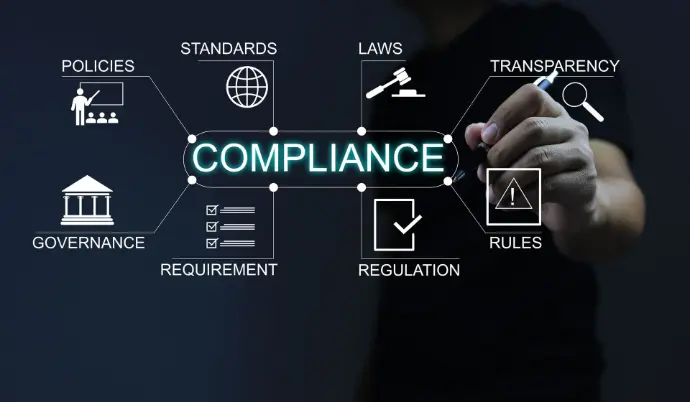DORA Compliance
Digital Operational Resilience Act (DORA) Compliance
The EU's Digital Operational Resilience Act (DORA) is in force as of January 17, 2025. It sets clear requirements for financial institutions, from banks to insurers to fintechs, on how to manage ICT risks, report incidents, test resilience, and oversee third-party providers.
Missing a deadline or misunderstanding an obligation can lead to regulatory fines, service disruptions, reputational damage, and audit overhead.
Secure your path to compliance now.
Book a DORA Readiness Call or Request a Proposal for a clear, step-by-step plan.

Who Must Comply?
All regulated financial entities in the EU (more than 20 types), including:
- Credit institutions
- Payment and e-money institutions
- Investment firms
- Crypto-asset providers (under MiCA)
- Insurance/reinsurance firms
- Trading venues
- Credit rating agencies

What Does DORA Require And Why Does It Matter?
DORA applies to all entities providing financial services in the EU. It covers four main areas:
- ICT Risk Management
You must maintain policies, controls, and governance for every system and process that relies on information and communication technology. - Incident Reporting
You have strict timelines to report any operational incident, cyber attack, system failure, or near-miss first to your internal team, then to regulators. - Digital Resilience Testing
Regular or penetration tests, scenario-based exercises, and threat simulations must validate that your systems and teams can withstand disruptions. - Third-Party Oversight
All ICT service providers (cloud hosts, software vendors, data centers) require continuous risk assessments, clear contractual terms, and exit plans.
For many organisations, these rules overlap with existing standards (ISO 27001, NIST) but introduce new deadlines, templates, and proof points.
Without a clear roadmap, you can end up with gaps in your policies, missing evidence for regulators, or ad-hoc incident responses that fall short of DORA’s timelines.
Your Compliance Journey with qsecure
Here's how qsecure guides you from uncertainty to full DORA compliance in 4 phases. Each step builds on the last, creating a clear narrative and a measurable path forward.
1. Kick-off Workshop
We begin with a 2-hour briefing with your leadership team. We explain exactly what DORA requires, calendar deadlines, and how your existing controls map (or don’t) to each article and annex.
2. Current-State Review
Through interviews, policy reviews, and system checks, we document your ICT risk management processes, incident response plans, testing routines, and third-party registers.
3. Gap Analysis Report
You receive a concise report highlighting which DORA requirements are already met, which need refinement, and which are missing entirely. Each finding ties back to a specific DORA clause.
1. Policy and Procedure Templates
We provide clear, ready-to-use templates for ICT risk policies, incident-reporting playbooks, and governance charters. Each template references the exact DORA article it satisfies.
2. Vendor Risk Blueprint
A standardized set of questions, contract clauses, and exit-plan guidelines ensures you can assess every ICT provider consistently and meet DORA’s oversight rules.
3. Roadmap and Timeline
You’ll see a prioritized schedule week by week detailing when policies are finalized, when training is delivered, and when tests take place, all aligned to predefined deadlines.
1. Business Impact Analysis (BIA) and Critical Process Identification
Conducting a Business Impact Analysis (BIA) is a foundational step in building operational resilience and aligning with regulatory requirements such as DORA. The primary objective of the BIA is to identify and prioritize critical business processes based on their impact on the organization’s ability to deliver essential services. Recognizing which functions are vital to continued operations enables informed decision-making around continuity planning, resource allocation, and ICT risk management. The identification of these critical processes is a top priority, as it directly informs the design of incident response strategies, recovery objectives, and third-party dependency assessments.
2. Policy Deployment
We work with your teams to customize and approve each policy, ensuring roles, responsibilities, and escalation paths are clear.
3. Tool Selection and Implementation Support
We support you in selecting and configuring the appropriate tools tailored to your organization’s needs, ensuring alignment with DORA requirements and identified gaps.
4. Security Awareness and Policy Training
We deliver targeted security awareness programs designed to enhance organizational resilience by equipping personnel with the knowledge needed to recognize and respond to cyber risks. In parallel, we provide training on newly adopted policies and procedures implemented to meet DORA compliance requirements, ensuring staff understand their roles and responsibilities within the updated operational framework.
1. Tabletop Exercises & Incident Simulations
We facilitate realistic incident scenarios to evaluate your organization's ability to respond effectively under pressure. These exercises test internal communication flows, decision-making, and coordination with critical ICT third-party providers, ensuring your teams can meet DORA’s stringent incident notification timelines.
2. Security Testing & Technical Validation
Our expert security team performs targeted penetration tests and controlled exploit simulations on high-risk systems. Each activity is thoroughly documented to provide actionable insights and evidence of your resilience posture, supporting continuous improvement and regulatory readiness.
Take Control of Your Digital Resilience
DORA compliance doesn’t have to be a scramble in the months before a deadline.
With a clear, step-by-step journey and practical tools, you can embed operational resilience into your daily operations.
In 30 minutes, we’ll review your current posture and map out your compliance roadmap.
Tell us about your organization, and we’ll send a tailored plan, schedule, and cost estimate.